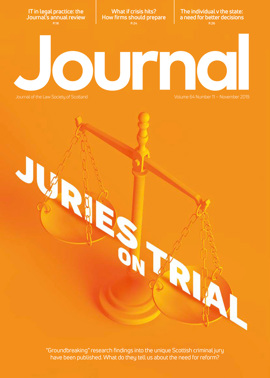Legal IT: an ever closer bond

Steadily, the momentum is building behind legal technology. We are seeing the dots being connected; the landscape filled in. Innovation is top of the agenda for law firms and clients alike. A picture is emerging of what a technology-enabled law firm and lawyer will look like over the next few years. The profession is, of course, a broad church and what is true for big law will not apply to the high street practitioner in the same way. But there is a key theme in common across the legal community, which is a drive to make better use of processes, data and technology to enable lawyers to be more efficient and to provide a better service.
Meeting of minds
It is really interesting to see how this is playing out in practice. Take process improvement. The earliest examples of legal technology needed a streamlined process to work optimally. Unfortunately, these processes were not the ones that lawyers typically used. Bridging that gap proved a real challenge. What we are now seeing is a meeting of minds in the middle. Lawyers have realised that much of what they can do can be reduced to a core, repeatable process, and that retaining flexibility does not require constantly reinventing the wheel.
Technology vendors have also been engaging with the profession, working on pilot schemes and making sure that the process flows embedded in their tools match the way that lawyers work in practice.
Even better, vendors are delivering products which are more configurable and can communicate (either directly or via independent platforms) with each other, offering a much better “end-to-end” service. The result has been remarkable, with products now delivering real benefits and fitting in effortlessly to a surrounding business process. Examples we are seeing include efficient and streamlined technology improving areas such as client take-on, contract drafting and legal risk assessments.
The oft-repeated fear that lawyers would not invest in processes which reduced their ability to charge by the hour has not been borne out. Why is that? Client pressure has certainly helped, by minimising fee increases, and moving to using fixed fees for larger portfolios of work. Clients have also made evidence of innovation a priority when selecting their advisers. That is not the whole story though. Firms, driven by the combination of in-house technology professionals, process engineers, and the desire of a significant minority of forward-thinking lawyers to “do things differently”, have enthusiastically driven the pace. It has been helped by a growing recognition that in a competitive market, firms can leapfrog their peers through embracing the change agenda.
For smaller firms, the focus will remain on replacing legacy systems, which have often been acquired piecemeal, with new systems which provide whole practice management solutions. These will largely be cloud-based. The new systems will drive the business processes in firms to be more streamlined.
This technology-enabled transformation is also bringing benefits in introducing more security, resilience and availability to a portion of the market which has not historically had access to such depth of resources.
What your data can do
Another key theme is better use of data. Until relatively recently, the data generated in the course of providing legal advice was not something anyone particularly thought about, let alone captured systematically, save so far as it related to the ability to get paid. Now, we have entire industries built on nothing more than the leveraged power of data.
Law firms may be late to the party, but they are making up for lost time with the use of legal technology. New systems are allowing transaction data to be captured in real time from the very outset. This avoids the need for time-consuming rekeying. These data encompass aspects such as identifying the instructing individual (for example, is one person repeatedly asking the same questions?) and highlighting the speed of each stage (where are the blockers?) and the cost of certain activities (do we need to spend time perfecting a part of the contract that is rarely relied on?). The data and learnings are then being used to inform the design of, and even train, tools. As a result, we see lawyers deploying products which, having captured data from litigation outcomes or contract negotiation positions, can guide clients on what strategic approach to take in the future based on evidence-based, statistical analysis.
Empowered clients
We also see technology being used to better present data for analysis. This can be used both internally in law firms and externally with clients, in each case to understand how matters are progressing and to better inform decisions, both short and long term. A common example is dashboard technology. This presents clients with a single view of all current matters, with the ability to drill down into the topic, status and financial details at will. These dashboards can easily be designed with multiple users in mind, each sharing a common central database, but with different views tailored to their particular permission levels and areas of interest. This is a small revolution in lawyer-client communication, in that it shifts the balance of power back to clients with real time visibility of data. The openness which this brings has benefits beyond the specifics of transactions and is helping to foster collaboration and trust across the relationship.
Data as trainers
I mentioned above that data are being used to train tools. The main focus in this area is in relation to the much used (and possibly also misused) term of artificial intelligence. The idea that tools can replicate what we currently consider to be human-only activity is both exciting and controversial. At the moment, such tools are growing in power and functionality. However, the amount and quality of data which is available to train the tools is currently a significant limiting factor in realising their full potential. As a result there is a lot of time and energy being spent on finding these data and then using the data to train the tools.
At the moment, even the largest firms are struggling with the size of the data sets required. This is leading to industry-wide efforts to agree common data standards and ways of anonymising data to enable it to be shared.
One open question is to what extent firms will be willing to allow suppliers to use these data to train products for general use (as opposed to being limited to only the firms which supply the data).
What’s trending
Finally, if we look at the current trends regarding how firms are approaching the job of actually delivering the benefits of legal technology to clients, we see a variety of options being used. Some firms are using their own in-house teams, made up of legal technologists, data scientists and coders. These teams are able to configure both third-party technology packages and the firm’s own bespoke developments, prepare data sets in the required format, and carry out API (application program interface) development to link products together, to create an overall solution for the particular needs of individual clients. Another approach is to make use of larger platform technologies which are available and which (increasingly) come with their own suite of products which can be rapidly deployed at less effort, but may involve some compromise on the precise functionality the client wants.
As a middle ground between these two approaches, we are also seeing a variety of “building block” technologies becoming available, which are capable of being linked together and configured using a low-code or no-code approach. This final option gives more power directly to legal professionals, to enable them to digitise an existing process and quickly spin-up a solution for their clients.
Putting all these together, we are on the cusp of some very significant changes, both in efficiency of legal services and in the functionality benefits from harnessing technology. We are seeing law firms engaged in increasingly rapid incremental improvement and in radical change, and both are equally welcome. Whether in areas such as predictive tools for litigation and major improvements in practice management information, through to the ability to offer proactive advice even before legal issues seem to have arisen, firms of whatever size and work type, and their clients, are benefiting from the wider and wider use of legal technology. Ultimately, we will see lawyers, working with technology providers and other professionals as part of an integrated team, developing solutions which work seamlessly as part of the client’s own business process. The future of law is clearly one in which technology will play a major part.
Legal tech: What next?
We asked the suppliers advertising in this feature what they see coming down the road…
 LawWare
LawWare
Warren Wander, founder of the practice management software supplier, LawWare, believes the future of legal IT is all about getting the most out of new advances alongside existing solutions.
He states: “I expect new technologies like AI, blockchain and analytics to fulfil their potential in a way that complements existing tried and tested systems by integrating with them. The bottom line is that the new tech has to provide both greater efficiency for law firms and more rapid and responsive outcomes for clients.”
 Insight Legal
Insight Legal
The next big thing in legal tech? Acceleration of an existing trend around choice and flexibility. Smaller firms compete more effectively with larger ones thanks to cloud-based subscription software. This is good and widens choice. Clients consider the principal relationship is with their lawyer, not the legal brand.
Mobile apps and web conferencing mean access to legal advice is not just “when the doors of the firm are open”. Firms can offer access to lawyers at times to suit their clients. Legal staff are benefiting too. Technology enables flexible working practices, that support lawyers who choose positive career goals other than just partnership.
 Denovo
Denovo
"Technology can be your best friend, and be one of the most essential parts of your daily working life. As technology continues to increase our possibilities, what we’re seeing is a shrinking of the lag time between what we wish we could achieve and what we can create. The combination of human skills with technology will always be at the root of any solution to the future of your business. As more legal professionals devote more time to embracing tech and mentoring their teams, they will sow the seeds of a future workforce capable of using it to stay ahead of the pack.”
Grant Yuill, Head of Marketing, Denovo







